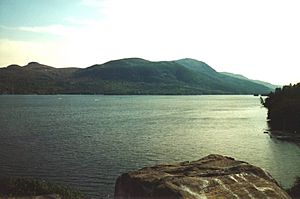Battle of Sabbath Day Point facts for kids
Quick facts for kids Battle of Sabbath Day Point |
|||||||
|---|---|---|---|---|---|---|---|
| Part of the French and Indian War | |||||||
 View of Lake George from Sabbath Day Point |
|||||||
|
|||||||
| Belligerents | |||||||
Indian allies |
|||||||
| Commanders and leaders | |||||||
| Strength | |||||||
| Approximately 450 | Approximately 350 | ||||||
| Casualties and losses | |||||||
| 1 wounded | Approximately 250 killed or captured | ||||||
The Battle of Sabbath Day Point was a quick but important fight during the French and Indian War. It happened on July 23, 1757, near Lake George, New York. This battle was actually an ambush where French and Native American forces surprised British soldiers. The French and their allies won this battle easily.
About 450 French and Native American fighters, led by Ensign de Corbière, ambushed 350 British soldiers. These British soldiers were from New Jersey and were called the "New Jersey Blues." They were led by Colonel John Parker. The French knew Parker's plan. They waited for his boats to come close to the shore. Parker's forces were completely surprised. They lost about 250 men, with many killed or captured. The French reported only one person slightly hurt.
Contents
Why Did This Battle Happen?
In March 1757, a French army tried to capture Fort William Henry. This fort was an important British outpost. The French tried for four days but could not take the fort. Bad weather and a lack of supplies stopped them. Even though they didn't capture the fort, the French destroyed many British boats. They also burned down buildings outside the fort.
After the French left, the British commander, Lieutenant-Colonel George Monro, said they had won. But losing so many boats was a big problem for him. He couldn't send out scouts to see what the French and Native Americans were doing. His soldiers were also not well-trained. This made it very risky to leave the fort's safety.
Raids and Reinforcements
During the spring and early summer, Native American groups often attacked from Fort Carillon. They were encouraged by the French, who gave them rewards like brandy and weapons. These groups would raid areas near Fort William Henry. They would capture or attack anyone who went outside the fort walls. Colonel Monro desperately needed information about enemy movements. But he couldn't do much until more soldiers arrived. He also didn't quickly rebuild the boats and buildings the French had destroyed.
Finally, in June, help arrived. Soldiers from New York, New Jersey, and New Hampshire came from Fort Edward. They were sent by General Daniel Webb. With these new soldiers, Monro decided it was time to act. He needed to find out what the French were planning.
How the Ambush Unfolded
Monro, who didn't have much battle experience, decided to send a large scouting party. He gathered all the boats he could. He put about 350 men into them. His plan was to send them north on Lake George. This area was controlled by the enemy, and Monro knew little about them. He chose Colonel John Parker to lead this group.
Setting the Trap
The plan was for Parker's men to land at Sabbath Day Point. This spot was about 20 miles (32 km) north of Fort William Henry. On July 20, three boats went ahead as an advance party. French scouts saw these boats. On July 21, about 450 French and Native American fighters left Fort Carillon. They were led by Ensign de Corbière. Their goal was to stop Parker's group.
The French ambushed Parker's three lead boats. The Native Americans questioned the captured British soldiers. The soldiers told them exactly where Parker planned to land. This information helped the French set a perfect trap. They placed musket-men along the shore. They also hid about 50 canoes with Native American warriors on the other side of the point.
The Surprise Attack
In the early morning of July 23, Parker's main group approached Sabbath Day Point. They didn't know that the French had captured their advance boats. They saw the three boats they had sent ahead and thought everything was fine. Three decoys (people pretending to be friendly) waved Parker's men towards the shore.
Once Parker's boats were close enough, soldiers and Native Americans hidden along the shore opened fire. At the same time, the canoes full of Native Americans appeared from around the point. They surrounded Parker's men. The Native Americans jumped into the water. They sank, flipped over, or captured almost all of Parker's boats. Many British soldiers were killed or drowned in the water. The battle was very one-sided. The British soldiers were terrified and quickly surrendered. Only about 100 of Parker's men, including Parker himself, managed to escape. Out of 350 men, nearly 160 were killed or drowned. The rest were taken prisoner.
What Happened Next?
Colonel Parker was lucky to escape. He led the few remaining soldiers through the thick forest back to Fort William Henry. The French and their allies loaded their prisoners and captured supplies into boats. Then they headed north.
Monro learned a very expensive lesson: there was a large enemy force further up the lake. The French used their victory to their advantage. They sent two groups south from Fort Carillon. One group traveled on Lake George. The other marched through the dense forest along the west side of the lake. After the defeat at Sabbath Day Point, these French forces met little resistance from the British. Their main goal was Fort William Henry. On the morning of August 3, the French came down the lake. They appeared in front of the British fort. The Battle of Fort William Henry was about to begin.

